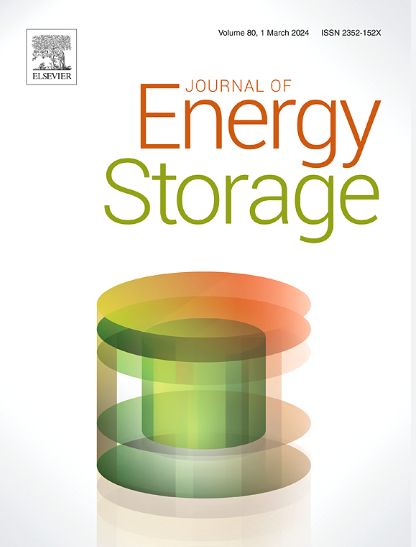一种新型螺旋壳管相变储能系统的蓄热性能
IF 8.9
2区 工程技术
Q1 ENERGY & FUELS
引用次数: 0
摘要
锥形螺旋壳管相变储热系统具有传热面积大、储热效率高等优点,但仍受到相变材料导热系数低和“熔化死区”问题的限制。因此,采用焓孔法数值分析了螺旋管直径、螺旋节距和螺旋锥度对新型锥形螺旋壳相变蓄热系统熔化过程的影响,并通过与传统圆柱螺旋管的对比验证了新型锥形螺旋管的优越性。结果表明,管径存在一个最佳阈值。在最佳管径条件下,系统熔化时间可缩短18.9%。此外,螺旋节距和低锥度对储热性能有显著影响。与传统圆柱螺旋管相比,新型螺旋管的平均蓄热效率提高了36.4%,系统的火用效率提高了6.4%。本研究为螺旋壳管相变蓄热系统的设计提供理论支持,促进可再生能源特别是太阳能的高效利用。本文章由计算机程序翻译,如有差异,请以英文原文为准。

Thermal storage performance of a novel spiral shell-tube phase change heat energy storage system
The conical spiral shell-tube phase change thermal storage system has the advantages of large heat transfer area and high thermal storage efficiency, but it is still limited by the low thermal conductivity of phase change materials and the problem of the “melting dead zone”. Therefore, the influence of spiral tube diameter, spiral pitch, and spiral taper on the melting process of the novel conical spiral shell phase change heat storage system is numerically analyzed using the enthalpy-porosity method, and the superiority of the novel conical tube is verified by comparing it with the traditional cylindrical spiral tube. The results indicate that the tube diameter has an optimal threshold value. Under the condition of optimal tube diameter, the system melting time can be shortened by 18.9 %. In addition, the spiral pitch and lower taper have a significant effect on the thermal storage performance. Compared with the traditional cylindrical spiral tube, the average thermal storage efficiency of the novel spiral tube is increased by 36.4 %, and the exergy efficiency of the system is increased by 6.4 %. This study provides theoretical support for the design of spiral shell-tube phase change thermal storage system, promoting the efficient utilization of renewable energy sources, particularly solar energy.
求助全文
通过发布文献求助,成功后即可免费获取论文全文。
去求助
来源期刊

Journal of energy storage
Energy-Renewable Energy, Sustainability and the Environment
CiteScore
11.80
自引率
24.50%
发文量
2262
审稿时长
69 days
期刊介绍:
Journal of energy storage focusses on all aspects of energy storage, in particular systems integration, electric grid integration, modelling and analysis, novel energy storage technologies, sizing and management strategies, business models for operation of storage systems and energy storage developments worldwide.
 求助内容:
求助内容: 应助结果提醒方式:
应助结果提醒方式:


